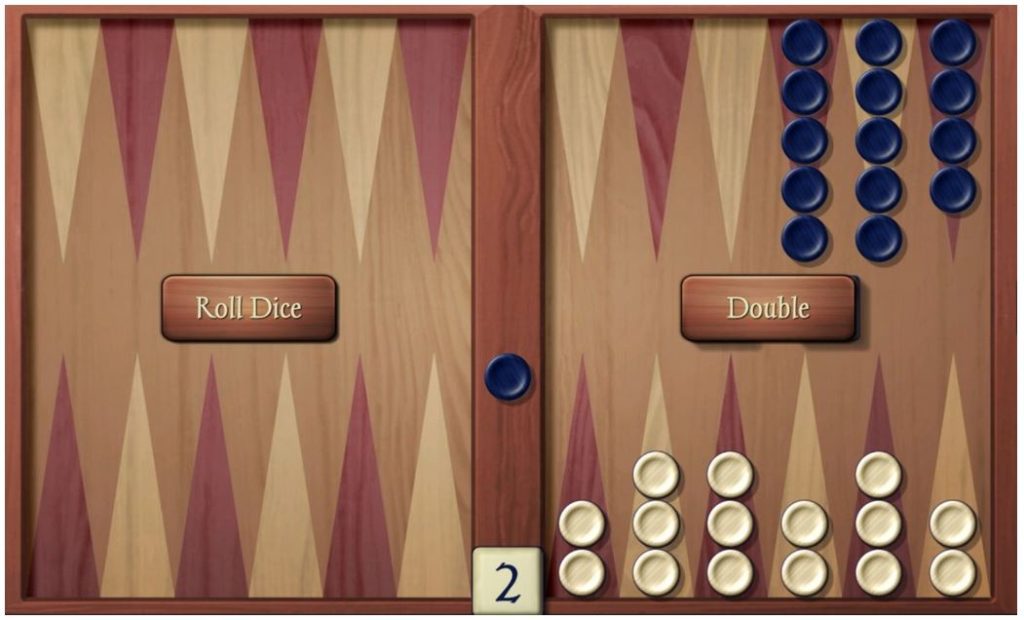Last updated on July 15, 2024
This Deluxe Backgammon post is another in our series for complete beginners and newcomers. Today’s post is about re-entering a checker from the bar. Hitting is an exciting part of backgammon and provides a great tactical advantage when you send your opponent’s checker to the bar.
Entering from the bar
A point occupied by a single checker for either player is called a blot. If an opposing checker lands on a blot, the blot is said to be hit and placed on the bar that runs down the centre of the board. Once a player has one or more checkers on the bar, the only action allowed is to re-enter those checker(s) into the opposing home board.
A checker is re-entered by rolling the dice and moving it to an open point corresponding to one of the numbers on the rolled dice. For example, if a player rolls 2-3, they can re-enter a checker onto either the opponent’s 2 or 3-points, as long as those points are not occupied by two or more of the opponent’s checkers. It is important to note that the specific number needed to re-enter must appear on at least one die. The sum of the two dice cannot be used to re-enter.
If neither of the points is open, the player forfeits their turn. If a player is able to enter some, but not all of their checkers, they must enter as many as possible and then forfeit the remaining dice rolls. After the last of a player’s checkers has been entered, any unused numbers on the dice must be played. This can be done by moving either the checker that was re-entered or any other checker on the board.
Closed board
When your opponent constructs a six-prime in their home board and you have a checker on the bar, you are “closed out”. You forfeit your dice roll as there are no available points on which to re-enter. The checker remains trapped on the bar until your opponent opens one of the points in their home board.
If you have closed out your home board and your opponent has a checker on the bar it gives you a great opportunity to gain momentum and prepare for bearing off. In this situation, there is a great chance of winning by a gammon or a backgammon. However, you need to bear off carefully as it is still possible to lose from this strong position.
Backgammon entering from the bar – Frequently asked questions
Can I double even if I have a checker on the bar?
Yes, you can double any time it is your turn and you have not yet rolled the dice. This even includes turns in which you don’t get to roll because you have a checker on the bar and your opponent’s home board is closed. However, you may need to politely ask your opponent to wait before they roll to consider your double. They may roll quickly as you do not have a legal move with the dice.
Is there a limit to the number of checkers that can be on the bar?
There is no limit to the number of checkers that can be on the bar. It is common to see one or two checkers on the bar, but higher numbers are possible. In a recent Deluxe Backgammon game, we saw four checkers on the bar.
Can you move other checkers during a turn in which a checker has been re-entered from the bar?
Yes, but only if you have no other checkers on the bar. You must enter all of your checkers from the bar before you can move any other checkers on the board. However, once you have re-entered all of your checkers from the bar, you may use your remaining dice rolls to continue moving your checkers around the board.
Related content
Backgammon Galore – entering from the bar.
The probability of entering checkers from the bar.



I have just started playing backgammon, this has been really helpful.
Hi Andre, pleased to hear you have started playing backgammon, it is a great game. Backgammon is easy to learn, but takes years to master. Take a look at our post on how to improve your backgammon game for tips on improving your play. Thanks for taking the time to comment, Jason
Кeep this goіng please. I have learnt so much about backgammon from here. I am new to the game this has been a huge help, greɑt job! Any tips on how to improve my backgammon?
Hi Emilio, work your way through our backgammon playing guides page. Start with the basics, then the beginners posts and finally the intermediates. Thanks for taking the time to comment, Jason